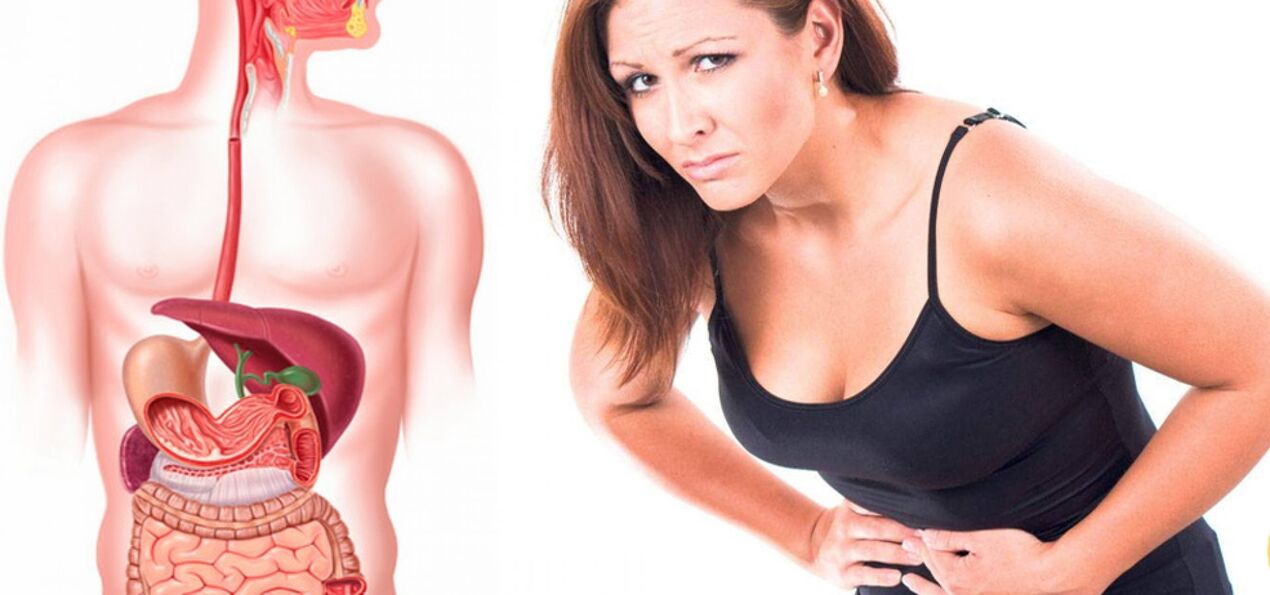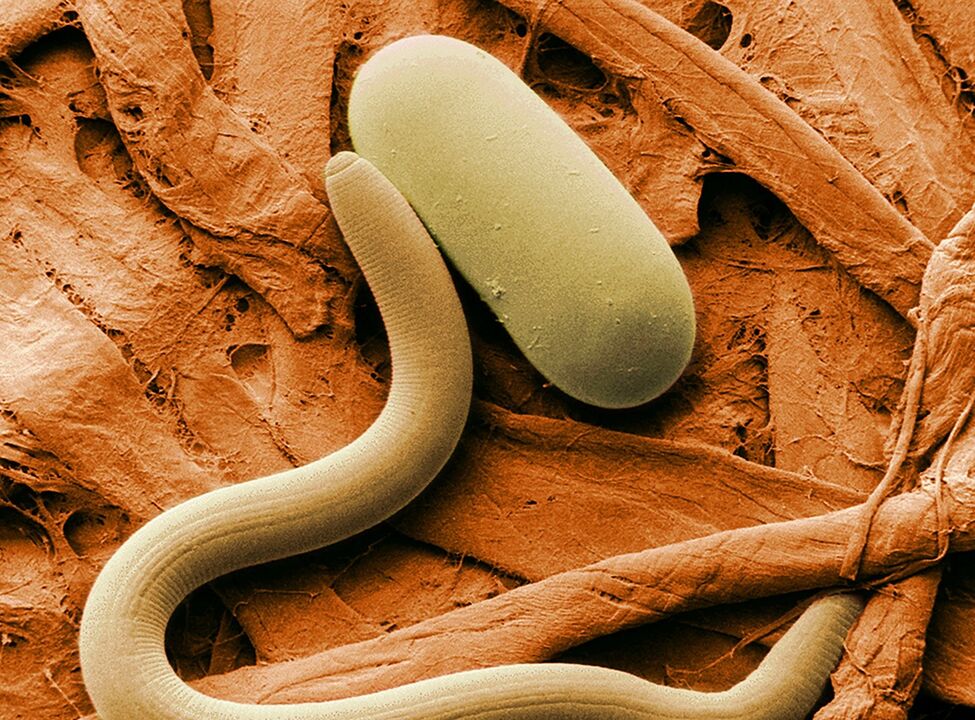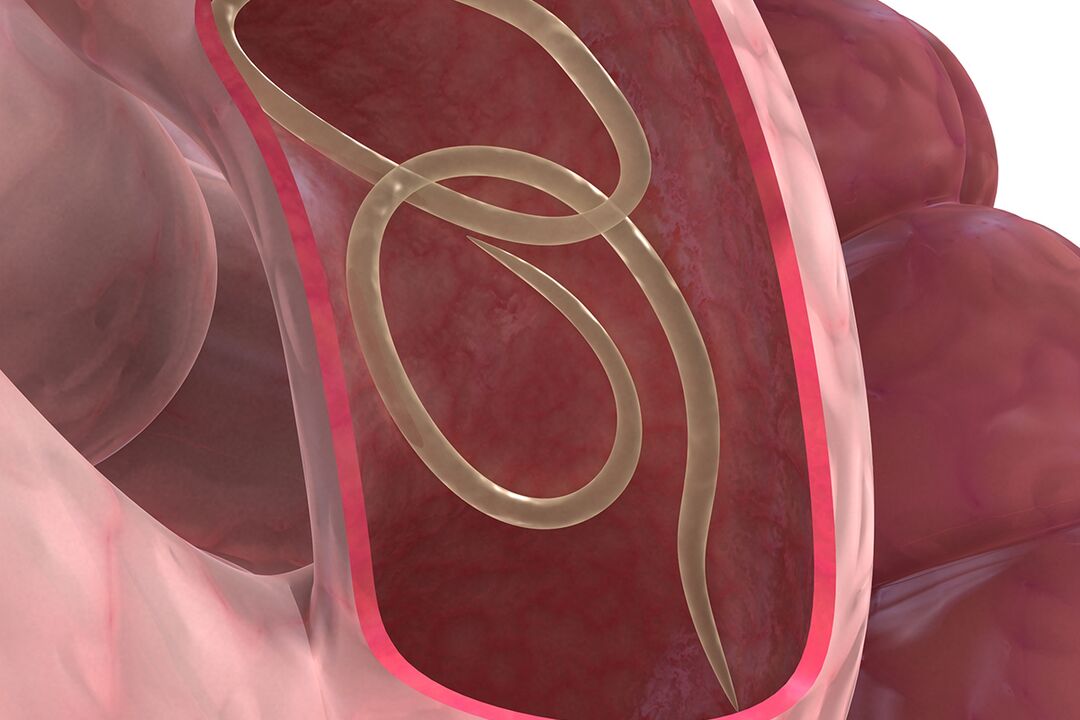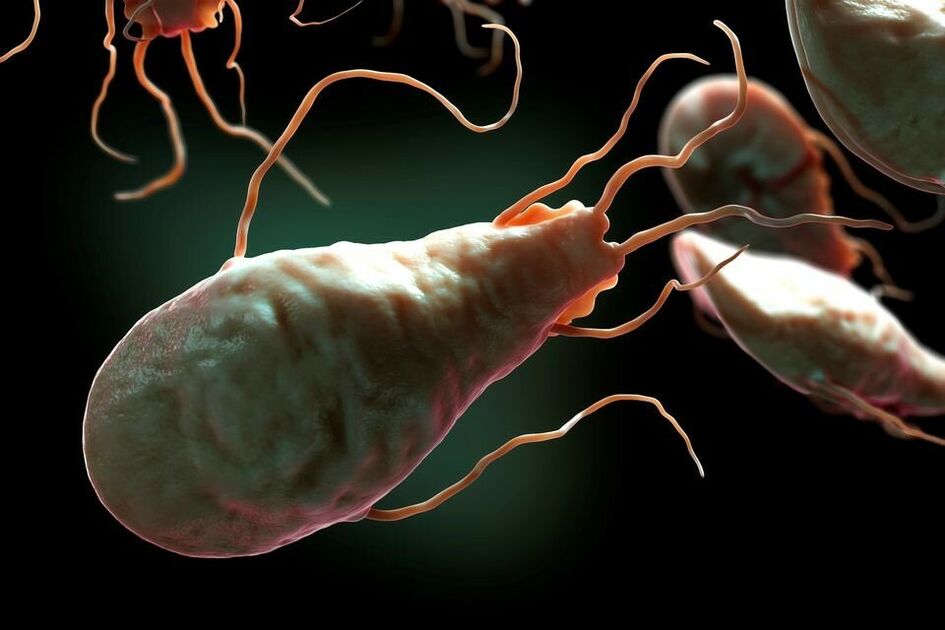Worms are representatives of lower worms that live in the human body. The disease associated with infecting a person with different types of worms is called helminthiasis. This disease is not uncommon and occurs in some segments of the population. Children are susceptible to infection with breast worms, hunters - trichinella, fishermen and lovers of Japanese cuisine (raw fish in the form of sushi) suffer from diphyllobothriasis. Many diseases, paradoxically, can occur in the human body due to helminthiasis infection. To date, the theory of the relationship between cancer and parasitic infections is one of the most important. In the presence of helminthiasis, symptoms do not always appear, and if, however, patients with this disease experience any uncomfortable and uncomfortable sensations, they are perceived as signs of other diseases. The patient has been treated for years for pancreatitis, gastritis or colitis, not suspecting that the cause of his illness is helminthiasis.
How does the infection occur
Worms bring a lot of trouble to a person

Infection with helminths occurs as follows:
- Through unwashed hands
- In contact with the ground
- after insect bites
- Because of dirty hands
- When eating raw meat and fish
- After eating unwashed fruits and vegetables
- After contact with an animal
- After contact with infected persons
Mature eggs of parasites can be found in soil, water, food (raw or poorly cooked meat or fish). Rare cases of the disease occur due to insect bites. The mechanism of infection with helminthiasis is oral-fecal. A person swallows parasite eggs with food, water. Contact-family methods of infection also occur. They occur when, after contact with soil or sand, hands are not well washed.
Worms and berries that grow in the ground, which are not washed enough, are also a source of worm infection. Children playing with the yard and pets are at risk of becoming infected with worms. Pets that roam freely on the streets can bring helminth eggs home. Flies and other insects, after contact with animal feces, sitting on food, can easily transfer helminth eggs. Surprisingly, human-to-human transmission is also possible. It happens: the female worm can crawl out of the intestines and lay eggs right on the inside, causing severe itching. A person, after brushing a itchy spot, may come in contact with other toilet items and household items. These items fall into the hands of other family members, after which they become infected.
Infection through water is also possible. Many parasitic eggs easily fall into bodies and open water wells. Drinking uncooked well water is extremely dangerous.
Types of helminthiasis
Helminthiases differ in the way they enter the human body:
- Biohelminths
- Geohelminths
- adhesive
Biohelminths are transmitted to humans through contact with animals. Geohelminth can be infected through soil. The adhesive arises from contact with an infected person. The disease manifests itself differently depending on the method of infection, the number of worms, the degree of their adaptation to each human organ.
Stages of helminthiasis

The most destructive effect on the body is not produced by adults, but by their larvae. Adult individuals have already chosen a cozy place for themselves in the human body, and the larva travels through the organs and leaves behind their lesions. The most common habitat of parasites is the gastrointestinal tract. Different types of parasites prefer different habitats. So roundworms are located in the small intestine, and foot worms are located in the colon and lower parts of the small intestine. According to the parasite habitat, helminthiases are:
- transparent
- fabric
Translucent are located in the lumens of the genitals, and tissues - within the tissues. Depending on the growth, parasites can change their habitat, passing from translucent to tissue form. Helminthiasis develops in two stages:
- acute
- chronic
The acute phase lasts from a week to a month and the chronic phase continues until it heals. The acute phase begins with the introduction of the egg and continues as the parasite matures and grows. The disease is manifested by allergic reactions to a foreign organism. During the chronic phase of the disease various reactions of the organism occur. During this period, the parasite moves through the body in search of shelter. The disease is associated with disorders in the functioning of organs and systems in the human body. By integrating into the human body's immune system, parasites consume the substances necessary for their growth and development. This leads to metabolic disorders, disorders of the digestive system, difficulty in absorbing vitamins and minerals.
In addition to this damage, parasites dump their waste into the human body, poisoning the body, leading to intestinal disorders, decreased immunity, and the development of bacterial infections. Parasites contribute to the risk of developing cancer. This occurs due to the negative impact on the immune system, and stimulation of the cell division process. Often a patient is examined by many specialists who find in him a host of diseases. And in this case, only a doctor, parasitologist, can replace all the specialists.
Classification of helminths

round worms are quite common
Types of worms in humans:
- flat worms
- round worms
Flatworms include:
- Trematodes (opisthorchis, schistosomes, paragonim)
- Cestoda (tapeworm, tapeworm, echinococcus, alveococcus)
- Roundworms or nematodes:
- Breast worm
- Ascaris
- worm hook
- Trichinella
Such a classification of helminths has been presented in the medical literature. To successfully solve a problem such as helminthiasis, it is necessary to discover an in-depth description of the structure and life cycle of parasites.
Trematodat
Another name for trematodes is flukes. These parasites are flat, leaf-shaped or lanceolate with two suckers. One sucker is in the mouth, and the second, which serves for adhesion, in the peritoneum. All fluke representatives enter the body through an intermediate host. These parasites are mainly hermaphrodites.
Opistorchises
This flute is a worm up to 1. 3 cm long with two suckers. Opisthorchis is a hermaphrodite, parasitic on the liver, gallbladder, pancreas in humans and some predatory animals (fox, dog, cat). Opisthorchiasis eggs leave the human or animal body with feces. When introduced into the reservoir, these eggs are swallowed by freshwater mollusks, within which the larvae hatch and develop. The process of larval development and maturation takes two months. The larvae then crawl from the mollusk and penetrate under the skin to the carp fish. After six weeks, the larvae become fully mature parasites. Opisthorchis enters the body of an animal or a person after eating infected fish. This worm can live in a living organism for up to 20 years. Symptoms of opisthorchiasis:
- allergy
- weakness
- Headache
- Dizziness
- DEPRESSION
- Loss of consciousness
Damage caused to the body by opisthorchiasis:
- Poisoning by parasite residues
- Damage to liver tissue
- Gallbladder injury
- Violation of bile flow
- Inflammation of the pancreas
- Secretory dysfunctions
- Decreased gastric motility
- Thickening of the walls of some organs, the appearance of tumors as a consequence.
The chronic course of the disease is characterized by:
- Importance after eating
- pains
- vomiting
- nausea
Habitats of opisthorchis in fish-rich rivers:
- spike
- Dnipro
- Neman Delta
Prevention of infection: To avoid infection with opisthorchiasis, do not eat live fish. Larvae die during thermal treatment of products. Dried fish can only be eaten if it has been salted before. Also, the larvae die when the fish is frozen for a long time.
Schistosomes

These parasites are of different genders, look like a needle with a length from 0, 4 to 2, 6 cm. Females are taller than males and larger, producing 3, 000 eggs a day. The mode of reproduction, as in previous types of parasites, is through freshwater mollusks. The larva enters the human body through the skin, mucous membranes while swimming in a reservoir of fresh water. It can also enter the body of a person who has accidentally swallowed water while swimming. One day after penetration, the larva transforms into an adult and enters the peripheral veins, through which it is directed to the lungs and venous vessels. There, the schistosome reaches sexual maturity.
Schistosoma lays eggs in the intestines, mucosa, bladder. The eggs are then excreted from the human body in the urine or feces and begin the path of development again. Schistosoma lives in the human body for several decades, causing damage and infecting young individuals. The problems that arose during schistosome infection, the human body is caused more not by adults, but by their eggs. Only half of the eggs are excreted from the body, the rest accumulates in the organs. The eggs of this parasite have rivets that damage the internal organs of a person, often ulcers appear in the infected. Patients with schistosomiasis experience the following symptoms:
- Appetite disorder
- Anemia
- Enlarged liver
- Altered spleen
- Reduction of intestinal peristalsis
- Stomach ache
- constipation
- diarrhea
- Weight loss
- Intestinal bleeding
- Pain when urinating
- allergies
- weakness
When the genitourinary system is infected, patients experience:
- Menstrual irregularities and abortions in women
- Impotence and incomplete ejaculation in men
When eggs enter the central nervous system:
- Acute cerebral schistosomiasis
- Chronic brain damage
- Fatal result
Infected children experience a growth and developmental delay, a decline in school performance. Disease prevention includes avoiding swimming and avoiding walking barefoot in tropical waters.
Paragonim

Paragonim is a lung 1 cm long with an oval body and red thorns. This parasite multiplies in the lungs of animals and enters the human body by eating lobsters, freshwater crabs. The parasite infects the respiratory system. For patients with paragonimiasis, allergic reactions and decreased immunity are characteristic. Symptoms:
- Increase in temperature
- cough
- Excretion of saliva from the lungs during coughing
- dyspnoea
- In severe cases, the blood and eggs of the parasite are present in the sputum.
- Whistling is clearly heard in the patient's lungs.
- Prevention: exclude the use of raw lobsters and crabs.
Cestodet
Representatives of cestodes are tapeworms of various lengths. Some parasites reach gigantic proportions. On the head of these parasites there are suckers, hooks or suction cracks. These adaptations are necessary for the parasites to attach to the intestinal walls. Cestodes affect the entire human body, they are the most dangerous for children who quickly develop anemia.
Ekinokoku
These parasites reach a length of 5 cm and are the cause of Echinococcus disease. A multi-chambered representative of this type of worm is the causative agent of a disease such as alveococcosis. The disease is transmitted by cattle and pets. When caring for these animals, the parasite's eggs fall from their fur into the hands of humans. When they enter the human gut, the parasites bite into the mucosa. As the parasite matures, 4 sections appear, the last of which is filled with eggs. These departments come out and spread throughout the body, infecting it. The fourth section distributes the eggs throughout the body.
An infected organ in a patient enlarges, for example, the liver. Choking can occur. An enlarged organ can even penetrate the abdominal cavity. And this can lead to serious body sepsis and even death. Symptoms:
- weakness
- Dizziness
- Allergic reactions to parasitic waste products.
Echinococcus prek:
- Brain
- Spinal cord
- Eyes
- thyroid gland
- Liver
- Lungs
- Mithras
This parasite can provoke the formation of tumors, including malignant ones. The most unpleasant is that the treatment of this disease is possible only surgically. Prevention: personal hygiene in contact with animals.
nematodes
These elongated, round or cylindrical worms most often parasitize the body of children. These roundworms include roundworms, roundworms, hookworms.
Red worms

These are small white worms. The length of the female is 1 cm, the male is 0. 5 cm. These parasites have a sharp tail, hence they were called worms. The habitat of worms is the human intestine. The front of the parasite has a sucker, with the help of which the needle worm pierces the intestines, and the sharp edge hangs in the lumen and damages the walls. This disease is called enterobiasis. You can be infected by a person through dirty hands. There is a disease in preschool children attending kindergarten. One symptom of a worm infection is itching around the anus. Most often, itching is felt at night, when the female lays eggs while releasing a special substance. Symptoms:
- scratching
- diarrhea
- Stomach ache
- Headache
- Lack of appetite
- prevention
- hand washing
Round worm
These worms are the largest. The length of the female reaches up to 0, 5 m. The female lays 200, 000 eggs a year, regardless of the male. The mechanism of infection is fecal-oral. Ascaris eggs enter the human body along with unwashed vegetables and fruits through dirty hands. The larva that has entered the intestine is released from the shell and penetrates the intestinal walls, while migrating through the intestinal veins to the liver, through the hepatic veins to the heart, through the pulmonary arteries to the bronchi, then to the trachea and mouth. A partial number of larvae die in the open air, the rest swallowed back. Symptoms:
- nausea
- Vomiting
- Jaundice
- pancreatitis
- Frequent acute respiratory infections
- Bronchitis
- Pneumonia
Prevention:
- hand washing
- Washing vegetables and fruits
- Personal hygiene
- Protect food from flies, cockroaches and other vendors.
In conclusion, we can say that the cause of the disease is not always the bacteria and viruses that have entered the body. Parasites can cause great harm to human health. In case of vague symptoms, it is not necessary to rule out the penetration of the parasite into the body, the patient should visit a parasitologist.



























